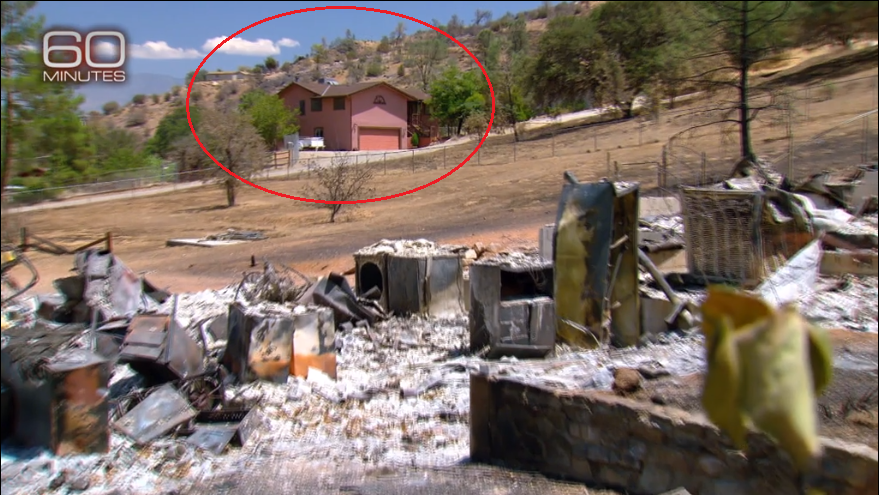60 Minutes Segment From May 2017 - How to Fire Proof a Home
A 60 Minutes segment called In the Path of Fire that ran just last year in May 2017, but many wildfires ago, described and showed the enormous difference fire-proofing a home can make. Just clearing a home's perimeter of debris goes a long way, as does installing ember-proof vents.
Circled in the photo above is the unscathed California home of retired firefighter Fred Roach.
A Montana firefighter named Jack Cohen said wildfires may be inevitable, but urban-wildfire disasters are very preventable. Cohen created a simulation lab in Montana to test debris-free home perimeters.
"At no point did anybody identify how homes ignited," Cohen said.
"What ignited this house and burned it down were the little things," he added. The segment continues:
A government grant was announced months ago in the S.F. Chronicle that homeowners could apply for to fund these types of fire-proofing construction and tree-trimming projects. We will add the grant information when and if we track it down.
Full 60 Minutes Segment: In the Path of Fire unfortunately behind a paywall, is available to CBS All Access subscribers here.

This work by AJ Fish is licensed under a Creative Commons Attribution-NonCommercial 4.0 International License.
Circled in the photo above is the unscathed California home of retired firefighter Fred Roach.
Fred Roach: This house here was prepared. And did not need ... the air tanker full of retardant ... or the helicopter full of water ... or all the engines to protect it. It, it was, it protects itself.The 60 Minutes segment is worth viewing in full.
Voiceover: Fred Roach thought about fire when improving his home. And says anyone can do what he did.
FR: The house was stuccoed about five years ago. And we stuccoed everything under the eaves, the entire thing.
Steve Inskeep: Stucco's basically fireproof?
FR: Uh basically. Close to it. And then we took all the redwood decking off the deck and replaced it with synthetic.
SI: Which doesn't burn nearly as ... easily.
FR: No. No. We had, we had embers all over the deck and nothing happened.
SI: So now that you're retired, do you still find yourself mentally triaging houses as you drive past them? That one's defensible, that one is helpless?
FR: Sure we do.
A Montana firefighter named Jack Cohen said wildfires may be inevitable, but urban-wildfire disasters are very preventable. Cohen created a simulation lab in Montana to test debris-free home perimeters.
"At no point did anybody identify how homes ignited," Cohen said.
"What ignited this house and burned it down were the little things," he added. The segment continues:
Voiceover: The little things. Cohen learned that a wildfire throws up a *blizzard of embers* that wind can drive up to a mile. The embers, also known as firebrands, start new fires...if they land on something flammable. Like wooden shingles. Wooden decks. Firewood against a wall. Pine needles in a gutter.
JC: And most frequently the things it is igniting, is debris. Around the structure. It's the stuff that's there primarily because we live there.
VOICEOVER: Jack Cohen says he knows these are danger spots because he ran simulations with life-sized homes in a lab.
JC: We have fire brand generators. And you can watch millions of these brands then begin to collect wherever they land. If the base of the house has flammable material, we end up with fire. We see the gutters igniting and putting flame right up against the eave line. What if we don't have anything that can support fire within five feet of the structure? What if we don't have pine needles in the gutters? Right? Then the firebrands, it doesn't matter from how far they come, don't ignite anything.Clean gutters of debris. Swap out home vents for ember-proof vents. And a few other things like clearing tall trees of their branches within 20-50 feet of the ground can help. Mature tree trunks burn much more slowly than new branches and younger saplings.
Steve Inskeep: Just clean the gutters?
JC: Clean the gutters. Clean the debris off your deck.
A government grant was announced months ago in the S.F. Chronicle that homeowners could apply for to fund these types of fire-proofing construction and tree-trimming projects. We will add the grant information when and if we track it down.
Full 60 Minutes Segment: In the Path of Fire unfortunately behind a paywall, is available to CBS All Access subscribers here.

This work by AJ Fish is licensed under a Creative Commons Attribution-NonCommercial 4.0 International License.





